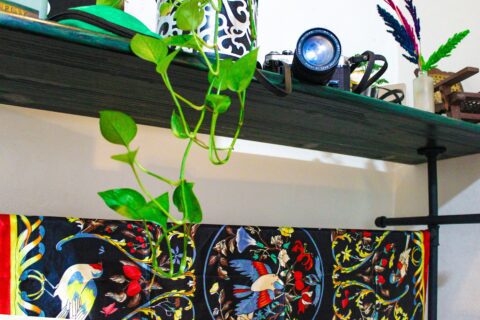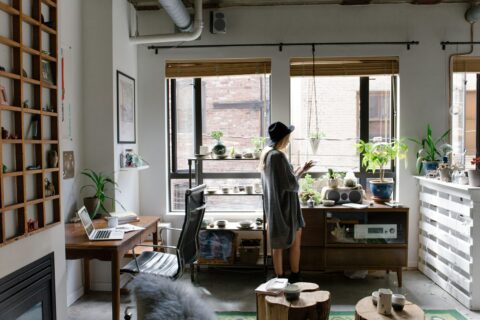Introduction to Home Harmony
Welcome to the world of Home Harmony, where design and balance come together in perfect harmony! Your home is not just a physical space; it’s an extension of your personality, reflecting your tastes, preferences, and style. Creating a harmonious environment within your living space can make all the difference in how you feel and function in your day-to-day life.
In this blog post, we will explore the concept of balance in design and how it plays a crucial role in creating a harmonious home. Whether you prefer sleek minimalism or eclectic bohemian vibes, achieving balance is key to making any style work seamlessly.
So get ready to dive into the fascinating realm of design equilibrium! Let’s discover how symmetry and asymmetry, color and texture, different styles, functionality and aesthetics all play their part in achieving that perfect state of Home Harmony.
The Importance of Balance in Design
The Importance of Balance in Design
Design is not just about aesthetics; it’s also about creating a harmonious and balanced space. Balance is crucial in design as it brings a sense of order, tranquility, and visual appeal to any room. It allows all elements within the space to work together cohesively.
Balance can be achieved through various techniques, such as symmetrical and asymmetrical arrangements. Symmetry creates a sense of equilibrium by evenly distributing objects or furniture on either side of an imaginary central axis. On the other hand, asymmetry introduces visual interest by placing different-sized or shaped objects strategically throughout the space.
Color and texture play significant roles in achieving balance too. By using complementary colors and textures that complement each other, you can create a visually pleasing environment where no single element dominates over others.
Integrating different styles seamlessly is another way to achieve balance in design. Mixing modern with traditional or minimalist with eclectic adds depth and personality to your home while maintaining an overall cohesive look.
In addition to aesthetics, functionality should not be overlooked when striving for balance in design. A well-designed space should not only look good but also fulfill its intended purpose efficiently.
Maintaining home harmony requires attention to detail and some practical tips can help achieve this goal: decluttering regularly, utilizing storage solutions effectively, incorporating natural light sources into your design plan are just a few examples.
By studying successful case studies where balance has been achieved expertly ensures you gain inspiration from those who have mastered this art form before finding what works best for your own unique style preferences.
Achieving Balance through Symmetry and Asymmetry
When it comes to achieving balance in design, symmetry and asymmetry play a crucial role. Symmetry refers to the use of identical or similar elements on both sides of a central axis, creating a sense of equilibrium and order. On the other hand, asymmetry involves using different elements that are visually balanced but not necessarily symmetrical.
Symmetry can create a harmonious and calming effect in a space. Think about perfectly matched furniture pieces placed symmetrically in a room – it creates an instant sense of balance and serenity. However, too much symmetry can also make a space feel static and predictable.
On the contrary, asymmetry adds visual interest and dynamism to a design. It allows for more creativity as you combine different shapes, sizes, and textures. For example, placing an oversized artwork on one side of the wall while balancing it with smaller decorative items on the opposite side can create an eye-catching focal point.
To achieve balance through symmetry or asymmetry successfully, consider how each element interacts with others within your space. Experiment with different arrangements until you find one that feels cohesive yet compelling.
Remember, balance doesn’t necessarily mean perfect symmetry; it’s about finding harmony between contrasting elements to create an overall pleasing aesthetic. So don’t be afraid to embrace both symmetry and asymmetry in your design journey!
The Role of Color and Texture in Creating Balance
The Role of Color and Texture in Creating Balance
Colors and textures play a crucial role in creating balance within a space. When used effectively, they can bring harmony to even the most chaotic environments.
In terms of color, contrasting hues can create visual interest while still maintaining equilibrium. For example, pairing bold accent colors with neutral tones can add depth without overwhelming the senses. Similarly, incorporating different textures adds another layer of balance to the design. Mixing smooth surfaces with rough ones or combining sleek materials with organic elements creates a dynamic yet balanced aesthetic.
Choosing the right color palette and texture combination depends on the desired atmosphere and mood you want to achieve in your home. Cool blues and greens evoke calmness and tranquility, while warm yellows and oranges exude energy and vibrancy.
Remember that balance doesn’t necessarily mean everything needs to be perfectly symmetrical or evenly distributed. It’s about finding harmony in the overall composition by strategically placing colors and textures throughout the space.
By carefully considering color combinations, incorporating various textures, you can achieve a cohesive look that promotes serenity while making a statement at the same time!
Incorporating Different Styles for a Balanced Look
Incorporating Different Styles for a Balanced Look
When it comes to design, mixing different styles can add a unique and eclectic touch to your home. But how do you create balance amidst this diversity? The key lies in finding the right harmony between contrasting elements.
One approach is to identify common themes or color palettes that can tie together disparate styles. For example, if you have a modern Scandinavian aesthetic in your living room, you could incorporate rustic elements like reclaimed wood furniture or vintage accessories. This creates visual interest while maintaining overall cohesion.
Another way to achieve balance is through strategic placement of contrasting pieces. If you have a minimalist bedroom with clean lines and neutral colors, consider introducing bold statement pieces such as an ornate chandelier or vibrant artwork. This juxtaposition adds depth and intrigue without overwhelming the space.
Don’t be afraid to experiment with textures and materials as well. Combining smooth surfaces with rough textures can create an interesting contrast that brings harmony to your design scheme. For instance, pairing velvet upholstery with exposed brick walls can result in a visually striking yet balanced look.
Remember that achieving balance doesn’t mean everything has to match perfectly; it’s about creating visual equilibrium within the space. By carefully curating different styles and incorporating them thoughtfully, you’ll achieve a harmonious blend that reflects your personal style while maintaining coherence throughout your home.
Balancing Functionality and Aesthetics in Design
Balancing Functionality and Aesthetics in Design
When it comes to designing our homes, we often find ourselves at a crossroads between functionality and aesthetics. We want our spaces to be visually appealing, but we also need them to serve a purpose. The key is finding the perfect balance between the two.
Functionality should never be sacrificed for the sake of aesthetics alone. After all, what good is a beautifully designed space if it doesn’t meet our everyday needs? On the other hand, focusing solely on functionality can result in a space that lacks personality and charm.
One way to achieve this delicate balance is by investing in furniture and decor pieces that are both functional and visually pleasing. Look for items that not only serve their intended purpose but also add beauty to your space. For example, opt for storage solutions that double as decorative elements or choose seating options that are comfortable yet stylish.
Another aspect to consider is the layout of your space. Think about how you move within the room and ensure that there’s enough open space for easy navigation while still maintaining an aesthetically pleasing arrangement. Avoid overcrowding with too much furniture or cluttering surfaces with unnecessary objects.
Color palette selection can also play a significant role in balancing functionality with aesthetics. Choose colors that promote productivity and relaxation depending on the function of each room while ensuring they harmonize well together visually.
Incorporating multi-functional elements into your design scheme can further enhance harmony between functionality and aesthetics. Seek out furniture pieces such as ottomans with hidden storage or coffee tables that convert into dining tables when needed.
Remember, achieving balance between functionality and aesthetics requires thoughtful consideration of every element in your home design – from furniture choices to color schemes – ultimately creating a harmonious living environment where both form and function coexist seamlessly without compromising one another’s importance
Tips for Maintaining Home Harmony
Tips for Maintaining Home Harmony
Creating a harmonious and balanced home is not just about the initial design choices; it also requires ongoing effort to maintain that sense of harmony. Here are some tips to help you maintain balance in your home:
1. Declutter regularly: Clutter can disrupt the visual flow and create a sense of chaos. Take time to declutter and organize your space on a regular basis. Donate or discard items that no longer serve a purpose or bring joy.
2. Keep things organized: Invest in storage solutions such as baskets, bins, or shelves to keep everything in its place. Develop systems for organizing everyday items like keys, shoes, and mail to prevent them from becoming sources of visual clutter.
3. Cleanliness is key: A clean home promotes feelings of calmness and order. Make cleaning a part of your routine by dedicating specific times each week for tasks like dusting, vacuuming, and mopping.
4. Balance lighting options: Lighting plays an essential role in creating ambiance and mood within a space. Incorporate different types of lighting sources such as overhead fixtures, floor lamps, table lamps, and candles to achieve balance throughout the room.
5. Embrace nature: Bringing elements from nature into your home can enhance its overall harmony. Add plants or flowers to purify the air while adding beauty and tranquility.
6 .
Create designated spaces for relaxation: Designate areas where you can unwind and relax after a long day – whether it’s by setting up cozy reading nooks or creating serene meditation corners – these spaces will help restore balance within yourself as well as your environment.
By implementing these simple tips consistently over time, you’ll be able to maintain the harmony within your home design effortlessly!
Case Studies: Examples of Home Harmony Done Right
Case Studies: Examples of Home Harmony Done Right
Let’s take a look at some inspiring case studies that showcase the art of achieving home harmony through balanced design. These examples will demonstrate how different elements come together seamlessly to create spaces that are both visually appealing and functional.
In our first case study, we have a modern living room with clean lines and minimalistic furniture. The symmetrical arrangement of the seating area creates a sense of order and balance, while pops of color in the form of throw pillows add visual interest without overwhelming the space.
Moving on to the kitchen, our second case study presents a perfect blend of symmetry and asymmetry. The central island acts as a focal point, flanked by matching cabinets on one side and open shelving on the other. This combination adds depth and dimension to the overall design while maintaining an overall sense of balance.
In another example, we explore a bedroom that incorporates different styles effortlessly. The eclectic mix of vintage pieces with contemporary accents is harmoniously tied together through careful attention to color coordination and texture selection. The result is a space that feels cohesive yet full of personality.
Not all homes are large or spacious, but careful consideration can still be given to achieving balance even in small spaces. Our final case study focuses on a compact home office where functionality takes center stage. By utilizing smart storage solutions and keeping clutter at bay, this workspace maintains its equilibrium despite its limited size.
These case studies serve as inspiration for anyone looking to achieve home harmony through thoughtful design choices. Remember, it’s not about adhering strictly to rules but finding what works best for your own unique style and preferences.
Conclusion: Finding Your Perfect Balance in Design
Finding the perfect balance in design is an ongoing journey. It requires a keen eye for detail, an understanding of different elements, and a willingness to experiment. But don’t be discouraged! Achieving home harmony is within reach.
Remember, balance can be achieved through symmetry or asymmetry, depending on your personal taste and style preferences. Experiment with color and texture to create visual interest and depth in your space. Don’t be afraid to mix different styles to create a unique look that reflects your personality.
At the same time, it’s important not to neglect functionality in pursuit of aesthetics. A well-balanced space should not only look good but also serve its purpose efficiently.
To maintain home harmony over time, consider decluttering regularly and keeping things organized. This will help create a sense of order and calmness in your living environment.
Now that you have learned all about achieving balance in design, it’s time for you to put these principles into practice! Take inspiration from the case studies provided or explore other sources of design inspiration.
Remember that finding your perfect balance may take some trial-and-error; what works for one person may not work for another. Trust your instincts and let your creativity guide you as you transform your home into a harmonious sanctuary.
So go forth with confidence and embark on this exciting journey towards creating a balanced oasis that truly reflects who you are!
Happy designing!







